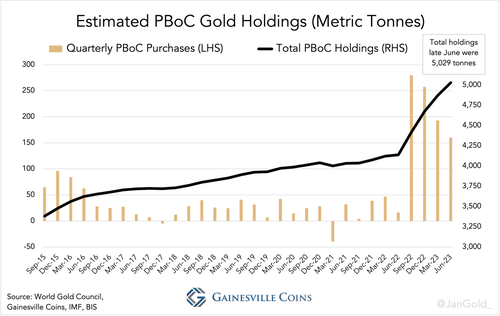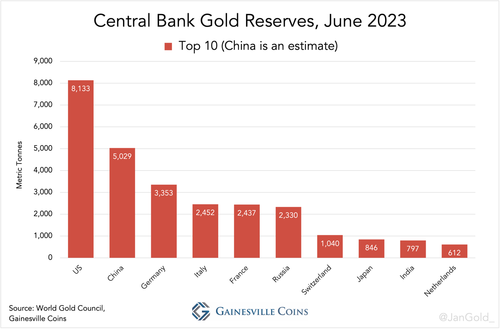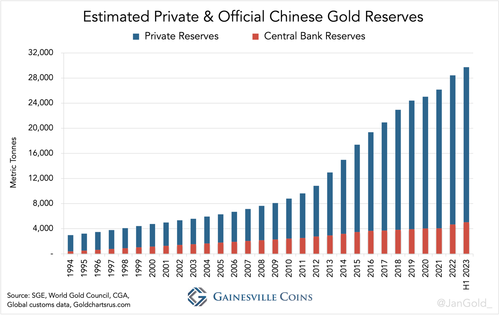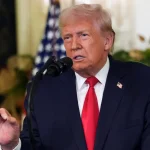
By Jan Nieuwenhuijs of Gainesville Coins
My estimate for China’s official gold reserves reached 5,029 tonnes by the end of June 2023. In the first six months of 2023 the Chinese central bank bought an estimated 353 tonnes. Although demand in H1 2023 was down 34% from H2 2022, demand was still strong and a driving force of the price of gold.

Measuring China’s Central Bank Gold Purchases
One of the best kept secrets in the world of finance is how much gold is owned by the Chinese central bank, the People’s Bank of China (PBoC). In a previous article I have explained that growth in PBoC gold reserves can’t be gauged by tracking how much gold is mined or net imported in China, because this is virtually all sold through the Shanghai Gold Exchange to the private sector. The PBoC acquires gold abroad with US dollars and ships the metal to Beijing without leaving a trace in customs reports. There is but one way to find out how much the Chinese central bank is buying: through people in close contact with the banks and refineries that deal with the PBoC.
My starting point is an educated guess shared with me in 2015 by an industry insider that worked for one of the large precious metals consultancy firms. According to this source the PBoC roughly held 3,300 tonnes by then. Two other sources familiar with the matter, but prefer to stay anonymous, told me unreported central bank purchases—the difference between total estimated central bank purchases and reported purchases—can be used to evaluate the PBoC’s quarterly additions. Unreported purchases can mostly be accredited to the Chinese central bank, they told me.
Every quarter the World Gold Council (WGC) publishes a single sum picturing how much gold is estimated to have been purchased by all central banks and international financial institutions combined. This estimate, based on public data and industry intelligence, includes reported and unreported purchases. From the WGC on their official sector estimate:
Net purchases (i.e. gross purchases less gross sales) by central banks and other official sector institutions, including supra national entities such as the IMF. Swaps … are excluded.
A … vital source is confidential information regarding unrecorded sales and purchases.
The WGC’s quarterly estimate is usually higher than what central banks report to have bought, any difference reflecting unreported purchases. For lack of an accurate cut, I guess eighty percent of these unreported purchases relate to covert PBoC shoppings. Anecdotal evidence assures me this is an appropriate percentage to use.
Let’s take the third quarter of 2022 as an example. The WGC disclosed central banks bought an estimated 459 tonnes of gold during this period. Reported purchases by all central banks accounted for 109 tonnes*. Eighty percent of the 350 tonnes difference is 280 tonnes, which is what the PBoC surreptitiously obtained (during Q3 2022 reported changes by the PBoC of its official gold reserves were zero). In December 2022, the Financial Times wrote regarding the Chinese central bank’s secret buying in Q3 2022:
Mark Bristow, chief executive of Barrick Gold, the world’s second-largest gold miner, said China had bought tonnes of gold around the high-200s mark, based on his discussions with numerous sources.
Bristow’s ballpark estimate at “the high-200s mark” matches my estimate of 280 tonnes, confirming my approach is reasonable.
Conclusion
The PBoC reported to have bought 103 tonnes over the first six months of 2023, while unreported purchases accounted for 250 tonnes, totalling 353 tonnes in net additions. Although PBoC purchases in H1 2023 were down 34% from H2 2023, demand was still robust and likely a driving force of the gold price during this period. Elevated central bank buying is expected to sustain, support the gold market's long-term bullish trend, and stimulate private demand.

Altogether, my best guess is that the Chinese central bank currently holds 5,029 metric tonnes of gold in total**, which is almost 3,000 tonnes more than what is reported at 2,113 tonnes. My estimate would make China the second largest official gold reserve country after the US.

My estimate for private gold reserves in China stands at 24,698 tonnes, and thus total reserves within the mainland are 29,727 tonnes. In my previous article I have explained in detail how I calculate private gold holdings in China.

Notes
* Against my expectations, measuring reported World official gold holdings is not easy. Many central banks don’t report to the IMF how much gold they have, or report with a lag. For the countries that stopped reporting, such as Iran and Syria, the IMF carries forward the last available data point. With a lag of a few months the IMF reports its own estimation of World holdings, but it’s unknown how this is calculated. Hence, I prefer not to rely on the IMF’s World series.
In addition to the WGC’s lump sum of total estimated purchases, it also publishes quarterly and monthly series—“Quarterly times series on World Official Gold Reserves since 2000” and “Changes in World Official Gold reserves”—that enclose reported net purchases per country. However, the latter two data sets each have their limitations. The “Quarterly times series on World Official Gold Reserves since 2000” doesn’t include every country, and in the “Changes in World Official Gold Reserves” the BIS and ECB are excluded, by way of example.
For my personal valuation of reported World official gold holdings, I track the same central banks and institutions as the WGC for their quarterly estimate, to get the difference between them as accurate as possible. I start off with what is reported to the IMF and use a country’s last reported figure if they stopped reporting. I compare these numbers to the WGC’s “Changes in World Official Gold Reserves” and make changes if necessary. I include the BIS’s own gold reserves (not any swaps on its balance sheet), as well as the IMF and ECB’s own gold. Gold liabilities on the balance sheet of the Turkish central bank are excluded, in the same way the WGC does. For Australia I count all gold and gold receivables, so also gold lent out. Known gold reserves from sovereign wealth funds and ministries of finance are also included.
** In my prior article on estimating the PBoC’s gold reserves I tallied unreported purchases but wrongly excluded reported additions after 2015. Mea culpa! In the above analysis both are incorporated.
By Jan Nieuwenhuijs of Gainesville Coins
My estimate for China’s official gold reserves reached 5,029 tonnes by the end of June 2023. In the first six months of 2023 the Chinese central bank bought an estimated 353 tonnes. Although demand in H1 2023 was down 34% from H2 2022, demand was still strong and a driving force of the price of gold.

Measuring China’s Central Bank Gold Purchases
One of the best kept secrets in the world of finance is how much gold is owned by the Chinese central bank, the People’s Bank of China (PBoC). In a previous article I have explained that growth in PBoC gold reserves can’t be gauged by tracking how much gold is mined or net imported in China, because this is virtually all sold through the Shanghai Gold Exchange to the private sector. The PBoC acquires gold abroad with US dollars and ships the metal to Beijing without leaving a trace in customs reports. There is but one way to find out how much the Chinese central bank is buying: through people in close contact with the banks and refineries that deal with the PBoC.
My starting point is an educated guess shared with me in 2015 by an industry insider that worked for one of the large precious metals consultancy firms. According to this source the PBoC roughly held 3,300 tonnes by then. Two other sources familiar with the matter, but prefer to stay anonymous, told me unreported central bank purchases—the difference between total estimated central bank purchases and reported purchases—can be used to evaluate the PBoC’s quarterly additions. Unreported purchases can mostly be accredited to the Chinese central bank, they told me.
Every quarter the World Gold Council (WGC) publishes a single sum picturing how much gold is estimated to have been purchased by all central banks and international financial institutions combined. This estimate, based on public data and industry intelligence, includes reported and unreported purchases. From the WGC on their official sector estimate:
Net purchases (i.e. gross purchases less gross sales) by central banks and other official sector institutions, including supra national entities such as the IMF. Swaps … are excluded.
A … vital source is confidential information regarding unrecorded sales and purchases.
The WGC’s quarterly estimate is usually higher than what central banks report to have bought, any difference reflecting unreported purchases. For lack of an accurate cut, I guess eighty percent of these unreported purchases relate to covert PBoC shoppings. Anecdotal evidence assures me this is an appropriate percentage to use.
Let’s take the third quarter of 2022 as an example. The WGC disclosed central banks bought an estimated 459 tonnes of gold during this period. Reported purchases by all central banks accounted for 109 tonnes*. Eighty percent of the 350 tonnes difference is 280 tonnes, which is what the PBoC surreptitiously obtained (during Q3 2022 reported changes by the PBoC of its official gold reserves were zero). In December 2022, the Financial Times wrote regarding the Chinese central bank’s secret buying in Q3 2022:
Mark Bristow, chief executive of Barrick Gold, the world’s second-largest gold miner, said China had bought tonnes of gold around the high-200s mark, based on his discussions with numerous sources.
Bristow’s ballpark estimate at “the high-200s mark” matches my estimate of 280 tonnes, confirming my approach is reasonable.
Conclusion
The PBoC reported to have bought 103 tonnes over the first six months of 2023, while unreported purchases accounted for 250 tonnes, totalling 353 tonnes in net additions. Although PBoC purchases in H1 2023 were down 34% from H2 2023, demand was still robust and likely a driving force of the gold price during this period. Elevated central bank buying is expected to sustain, support the gold market’s long-term bullish trend, and stimulate private demand.

Altogether, my best guess is that the Chinese central bank currently holds 5,029 metric tonnes of gold in total**, which is almost 3,000 tonnes more than what is reported at 2,113 tonnes. My estimate would make China the second largest official gold reserve country after the US.

My estimate for private gold reserves in China stands at 24,698 tonnes, and thus total reserves within the mainland are 29,727 tonnes. In my previous article I have explained in detail how I calculate private gold holdings in China.

Notes
* Against my expectations, measuring reported World official gold holdings is not easy. Many central banks don’t report to the IMF how much gold they have, or report with a lag. For the countries that stopped reporting, such as Iran and Syria, the IMF carries forward the last available data point. With a lag of a few months the IMF reports its own estimation of World holdings, but it’s unknown how this is calculated. Hence, I prefer not to rely on the IMF’s World series.
In addition to the WGC’s lump sum of total estimated purchases, it also publishes quarterly and monthly series—“Quarterly times series on World Official Gold Reserves since 2000” and “Changes in World Official Gold reserves”—that enclose reported net purchases per country. However, the latter two data sets each have their limitations. The “Quarterly times series on World Official Gold Reserves since 2000” doesn’t include every country, and in the “Changes in World Official Gold Reserves” the BIS and ECB are excluded, by way of example.
For my personal valuation of reported World official gold holdings, I track the same central banks and institutions as the WGC for their quarterly estimate, to get the difference between them as accurate as possible. I start off with what is reported to the IMF and use a country’s last reported figure if they stopped reporting. I compare these numbers to the WGC’s “Changes in World Official Gold Reserves” and make changes if necessary. I include the BIS’s own gold reserves (not any swaps on its balance sheet), as well as the IMF and ECB’s own gold. Gold liabilities on the balance sheet of the Turkish central bank are excluded, in the same way the WGC does. For Australia I count all gold and gold receivables, so also gold lent out. Known gold reserves from sovereign wealth funds and ministries of finance are also included.
** In my prior article on estimating the PBoC’s gold reserves I tallied unreported purchases but wrongly excluded reported additions after 2015. Mea culpa! In the above analysis both are incorporated.
Loading…






